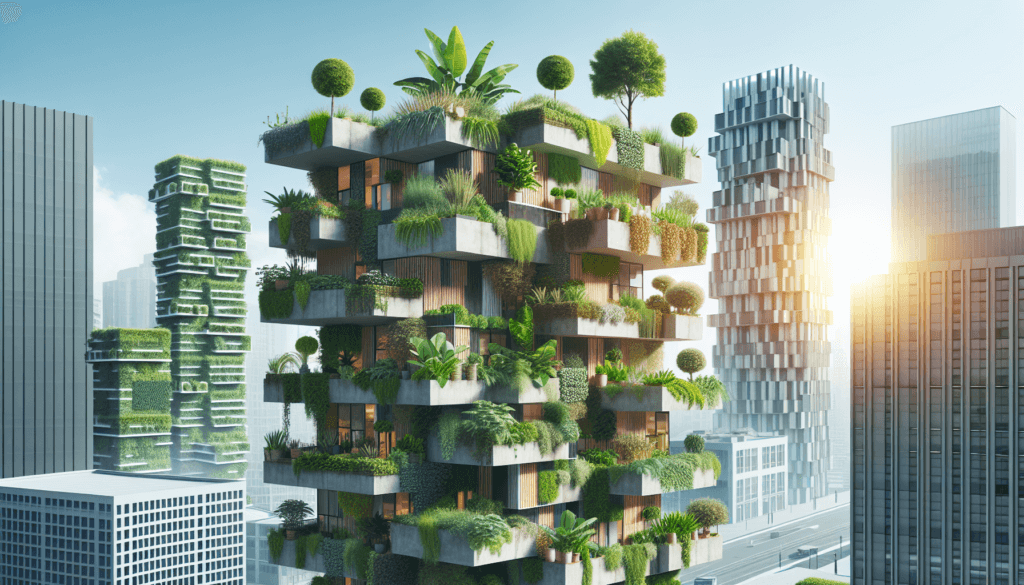Imagine transforming your small, concrete balcony into a lush oasis bursting with vibrant flowers and thriving herbs. With Urban Gardening Designs, you can effortlessly create your own green haven in the heart of the city. Our unique designs are tailored specifically for urban spaces, maximizing every inch of your limited area. Say goodbye to bare walls and embrace the serenity of nature right at your doorstep. Let us guide you on a journey of urban gardening, where even the smallest of spaces can become a flourishing botanical marvel.

1. Vertical Gardening
Vertical gardening is a popular and innovative way of maximizing your garden space, especially in urban environments where space is limited. It involves growing plants vertically, either on walls or trellis systems. This not only adds a beautiful aesthetic to your garden but also provides practical benefits such as improved air quality and insulation.
1.1 Green Walls
Green walls, also known as living walls or vertical gardens, are an excellent way to bring nature into your urban environment. These walls are covered with plants, creating a stunning and green backdrop. They can be installed both indoors and outdoors, adding a touch of nature to any space.
Green walls have several benefits, apart from their aesthetic appeal. They help to reduce air pollution by absorbing harmful pollutants and releasing oxygen. They also provide insulation, keeping your space cooler in the summer and warmer in the winter. Additionally, green walls have been shown to improve mental health and overall well-being by creating a calming and relaxing environment.
1.2 Trellis Systems
Trellis systems are another form of vertical gardening that can transform any outdoor space into a lush and vibrant garden. Trellises are structures made of wood or metal that allow plants to climb and grow vertically. They are versatile and can be attached to walls, fences, or stand-alone structures.
Trellis systems offer various benefits. They are perfect for growing climbing plants like ivy, roses, or jasmine, which can add both beauty and privacy to your garden. Additionally, they help to optimize space by utilizing vertical surfaces that would otherwise go unused. Trellis systems are relatively simple to install and require minimal maintenance, making them an ideal choice for beginners and those with limited gardening experience.
2. Container Gardening
Container gardening is a versatile and flexible way to bring greenery into urban spaces. It involves growing plants in pots, planters, window boxes, or hanging baskets. This allows you to create a garden on balconies, window sills, or even rooftops.
2.1 Window Boxes
Window boxes are a charming addition to any urban garden. They can be easily attached to the exterior of your window, adding a touch of greenery to your living space. Window boxes are perfect for growing small plants like herbs, flowers, or succulents.
One of the advantages of window boxes is their accessibility. They are easy to reach and maintain since they are at eye level. Additionally, they provide insulation, helping to regulate the temperature inside your home by reducing heat gain in summers and heat loss in winters. With a wide variety of materials and designs available, you can easily find a window box that complements the style of your home.
2.2 Hanging Baskets
Hanging baskets are a great way to add vertical elements to your garden. They can be suspended from balconies, porches, or pergolas, creating a beautiful display of cascading plants. Hanging baskets are perfect for growing trailing plants like petunias, lobelia, or ivy.
One of the advantages of hanging baskets is their versatility. They can be easily moved around, allowing you to change the look of your garden whenever you desire. Hanging baskets also save valuable floor space, making them an excellent choice for small urban gardens. It is important to ensure proper watering and drainage for hanging baskets to prevent overwatering or drying out.
2.3 Pots and Planters
Pots and planters are the most common and widely used containers for urban gardening. They come in various sizes, shapes, and materials, allowing you to create a personalized and functional garden. Pots and planters can be placed on balconies, rooftops, or even indoors, making them suitable for any urban space.
Using pots and planters provides flexibility in terms of plant selection, making it possible to grow a wide variety of flowers, herbs, or vegetables. They are easy to maintain and can be moved around to optimize sunlight exposure for your plants. It is important to choose pots and planters with proper drainage to ensure healthy plant growth and prevent waterlogging.

3. Roof Gardens
Roof gardens, also known as rooftop gardens or green roofs, are an innovative way to utilize barren rooftop spaces in urban areas. These gardens transform roofs into beautiful and productive spaces, providing numerous benefits for both the environment and the building occupants.
3.1 Intensive Roof Gardens
Intensive roof gardens are characterized by their high-level of soil depth, allowing for a diverse range of plants to be grown, including trees and shrubs. These gardens require careful planning and construction to ensure sufficient structural support and waterproofing.
Intensive roof gardens offer a multitude of benefits. They provide insulation, reducing energy consumption and costs by regulating the temperature inside the building. Intensive roof gardens also retain rainwater, reducing stormwater runoff and easing the strain on urban drainage systems. Moreover, they create an urban oasis, attracting birds, butterflies, and other wildlife.
3.2 Extensive Roof Gardens
Extensive roof gardens are designed with a shallower soil depth and are typically planted with low-maintenance vegetation such as sedum, grasses, or mosses. These gardens require less maintenance and lightweight materials, making them a more cost-effective option for urban environments.
Like intensive roof gardens, extensive roof gardens offer several advantages. They provide thermal insulation, reducing heat gain in summers and heat loss in winters, thereby decreasing the need for excessive heating or cooling. Furthermore, extensive roof gardens improve air quality by absorbing pollutants and releasing oxygen. They also help to mitigate the urban heat island effect by reducing the surface temperature of the roof.
4. Balcony Gardens
Balcony gardens are a popular choice for urban dwellers who have limited outdoor space but still want to enjoy the beauty of nature. With a little creativity and planning, you can transform your balcony into a lush oasis.
4.1 Vertical Planters
Vertical planters are a space-saving solution for balcony gardens. These planters can be attached to the wall or hung from railings, allowing you to maximize your vertical space. Vertical planters are perfect for growing herbs, flowers, and small vegetables.
One advantage of vertical planters is that they can be easily customized to fit your balcony’s size and style. You can choose from a variety of materials, such as plastic, ceramic, or metal, and arrange the planters in different patterns to create a visually appealing display. Vertical planters also provide easy access to your plants, making watering and harvesting a breeze.
4.2 Hanging Gardens
Hanging gardens add a touch of whimsy and beauty to your balcony. They can be created by suspending pots or baskets from the ceiling or attaching them to walls. Hanging gardens are ideal for growing trailing plants and colorful flowers.
One of the advantages of hanging gardens is that they free up valuable floor space, allowing you to make the most of your small balcony. They also create a sense of depth and dimension, adding visual interest to your outdoor space. Hanging gardens can be easily adjusted, making it convenient to move them around to optimize sunlight exposure for your plants.
4.3 Balcony Rail Planters
Balcony rail planters are designed to be attached to your balcony railing, instantly adding a burst of color and greenery to your outdoor space. These planters are available in various sizes and styles, allowing you to find the perfect match for your balcony.
One of the advantages of balcony rail planters is their versatility. They can accommodate a wide range of plants, from flowers to herbs to vegetables, depending on your preferences. Balcony rail planters are relatively easy to install and require minimal maintenance. They also provide a barrier between your balcony and the outside world, ensuring privacy and creating a cozy atmosphere.

5. Community Gardens
Community gardens are a wonderful way to bring people together and foster a sense of community in urban areas. These shared gardens are typically managed and maintained by a group of individuals who live in the same neighborhood.
Community gardens offer numerous benefits to the community as a whole. They provide access to fresh and healthy produce, particularly for those who may not have the space or resources to have their own gardens. Community gardens also promote engagement and social interaction among neighbors, strengthening community ties. Moreover, they can serve as educational spaces, where individuals can learn about gardening, sustainability, and the importance of healthy eating.
6. Indoor Gardens
Indoor gardens are a perfect solution for urban dwellers who lack outdoor space but still want to enjoy the benefits of gardening. These gardens can be created indoors, whether it’s in your living room, kitchen, or office, bringing nature into your daily life.
6.1 Hydroponic Systems
Hydroponic systems are a popular choice for indoor gardening. This soil-less growing method involves growing plants in nutrient-rich water solutions, allowing them to thrive without traditional soil. Hydroponic systems are highly efficient and provide precise control over plant nutrition and water supply.
One advantage of hydroponic systems is their space-saving nature. They can be designed to fit any indoor space, from small apartments to large commercial buildings. Hydroponic systems also facilitate faster plant growth and higher yields compared to traditional gardening methods. Moreover, they conserve water by recirculating it within the system, making them an eco-friendly choice.
6.2 Aeroponic Systems
Aeroponic systems are a cutting-edge method of growing plants indoors. These systems use mist or fog to deliver nutrients and water directly to the roots, resulting in faster growth and increased yields. Aeroponic systems are highly efficient and require less water and space compared to traditional gardening methods.
One of the advantages of aeroponic systems is their ability to promote the growth of healthy and robust plants. The mist or fog stimulates root development, leading to stronger plants. Aeroponic systems also provide precise control over environmental factors such as temperature, humidity, and nutrient delivery, ensuring optimal growing conditions for your plants.

7. Edible Landscaping
Edible landscaping is a creative way to combine aesthetic beauty with practicality. It involves incorporating edible plants into your landscape design, creating a stunning garden that not only looks good but also provides fresh produce.
Edible landscaping offers several advantages. It allows you to grow your own organic fruits, vegetables, and herbs, reducing your reliance on store-bought produce. Edible plants can be integrated seamlessly into your existing landscape, adding visual interest and diversity. Additionally, edible landscaping promotes sustainable gardening practices by utilizing space efficiently and conserving resources.
8. Permaculture Designs
Permaculture designs take a holistic approach to gardening, emphasizing sustainability, self-sufficiency, and ecological harmony. These designs incorporate elements such as companion planting, water catchment systems, and composting to create a balanced and productive ecosystem.
Permaculture designs offer numerous benefits. They promote biodiversity by creating habitats for beneficial insects, birds, and other wildlife. Permaculture gardens are also resilient and require less maintenance over time, as the ecosystem becomes self-regulating. Additionally, permaculture designs conserve resources by maximizing the use of organic matter, water, and sunlight.
9. Edible Walls
Edible walls, also known as food walls or vertical vegetable gardens, are a creative and space-saving way to grow your own food. These walls are covered with edible plants, providing a fresh and sustainable source of produce.
Edible walls offer several advantages. They optimize space by utilizing vertical surfaces, making them ideal for urban environments with limited garden space. Edible walls also provide insulation, reducing heat gain in summers and heat loss in winters. Additionally, they enhance air quality by absorbing pollutants and releasing oxygen, contributing to a healthier and more sustainable living environment.
10. Gardening in Small Spaces
Gardening in small spaces requires creativity and careful planning. However, even with limited area, it is still possible to create a beautiful and functional garden.
10.1 Window Sills
Window sills can be transformed into mini-gardens, bringing a touch of greenery into your home. You can use small pots or planters to grow herbs, succulents, or flowering plants on your window sills. Ensure that the plants receive adequate sunlight and regular watering to thrive.
10.2 Balconies
Balconies are excellent spaces for gardening, especially for those living in apartments. By utilizing containers, vertical planters, and hanging baskets, you can create a thriving garden on your balcony. Choose plants that are suitable for your balcony’s light conditions and ensure proper watering and maintenance.
10.3 Fire Escapes
Fire escapes, with their sturdy railings and ample sunlight, can serve as unexpected garden spaces. Hanging planters, railing planters, or even window boxes can be utilized to maximize the use of fire escapes for gardening. Before starting a fire escape garden, ensure that it complies with local regulations and does not obstruct any emergency exits.
In conclusion, urban gardening designs offer a multitude of options to bring greenery and nature into even the smallest of urban spaces. Whether it’s through vertical gardening, container gardening, or specialized techniques like hydroponics or permaculture, there is a gardening solution for everyone. By incorporating plants into your urban environment, you not only enhance the aesthetics but also contribute to improved air quality, sustainable living, and a stronger sense of community. So, go ahead and start your urban garden adventure to enjoy the many benefits it brings. Happy gardening!

